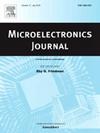A 8–10 GHz compact low noise amplifier MMIC with high linearity based on GaAs technology
IF 1.9
3区 工程技术
Q3 ENGINEERING, ELECTRICAL & ELECTRONIC
引用次数: 0
Abstract
This paper presents a two-stage high linearity low noise amplifier (LNA) implemented in a 0.25-μm GaAs pseudomorphic high electron mobility transistor (pHEMT) process. The LNA employs peaking inductors and source degeneration inductors to mitigate high frequency parasitic effects in transistors. The proposed linearity-enhancement architecture utilizes negative feedback and an auxiliary amplifier to suppress nonlinear distortion generated by the main amplifier. These methodologies collectively form an LNA operating in 8–10 GHz. Measured results indicate that the LNA achieves an average gain of 14.1 dB, a noise figure (NF) of approximately 4 dB, an input 1-dB compression point (IP1dB) of 2–4 dBm, and an output 1-dB compression point (OP1dB) of 14–15 dBm across the operational frequency band, with a compact area of 1.5 mm2.
一种基于GaAs技术的8-10 GHz高线性度紧凑型低噪声MMIC放大器
提出了一种采用0.25 μm GaAs伪晶高电子迁移率晶体管(pHEMT)工艺实现的两级高线性低噪声放大器(LNA)。LNA采用峰值电感和源退化电感来减轻晶体管中的高频寄生效应。提出的线性增强结构利用负反馈和一个辅助放大器来抑制主放大器产生的非线性失真。这些方法共同构成了工作在8-10 GHz的LNA。测量结果表明,LNA在整个工作频带内的平均增益为14.1 dB,噪声系数(NF)约为4 dB,输入1-dB压缩点(IP1dB)为2-4 dBm,输出1-dB压缩点(OP1dB)为14-15 dBm,紧凑面积为1.5 mm2。
本文章由计算机程序翻译,如有差异,请以英文原文为准。
求助全文
约1分钟内获得全文
求助全文
来源期刊

Microelectronics Journal
工程技术-工程:电子与电气
CiteScore
4.00
自引率
27.30%
发文量
222
审稿时长
43 days
期刊介绍:
Published since 1969, the Microelectronics Journal is an international forum for the dissemination of research and applications of microelectronic systems, circuits, and emerging technologies. Papers published in the Microelectronics Journal have undergone peer review to ensure originality, relevance, and timeliness. The journal thus provides a worldwide, regular, and comprehensive update on microelectronic circuits and systems.
The Microelectronics Journal invites papers describing significant research and applications in all of the areas listed below. Comprehensive review/survey papers covering recent developments will also be considered. The Microelectronics Journal covers circuits and systems. This topic includes but is not limited to: Analog, digital, mixed, and RF circuits and related design methodologies; Logic, architectural, and system level synthesis; Testing, design for testability, built-in self-test; Area, power, and thermal analysis and design; Mixed-domain simulation and design; Embedded systems; Non-von Neumann computing and related technologies and circuits; Design and test of high complexity systems integration; SoC, NoC, SIP, and NIP design and test; 3-D integration design and analysis; Emerging device technologies and circuits, such as FinFETs, SETs, spintronics, SFQ, MTJ, etc.
Application aspects such as signal and image processing including circuits for cryptography, sensors, and actuators including sensor networks, reliability and quality issues, and economic models are also welcome.
 求助内容:
求助内容: 应助结果提醒方式:
应助结果提醒方式:


